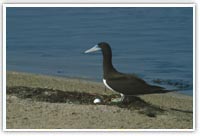
Breeding Sea Birds in the RSGA Region:
Overview: 
Coastal wetlands, the shallow waters adjacent to reefs and islands, and the numerous islands throughout the Region provide ideal habitat for a large number of seabirds. Some of the important resident species include the Lesser Flamingoes (Phoenicopterus minor) and the Yellow–vented Bulbul (Pycnonotus xanthopygos), while the important wintering species include the Greater Spotted Eagle (Aquila clanga), White–eyed Gull (Larus leucophthalmus) and the Greater and Lesser Sand Plover (Charadrius leschenault, C. mongolus). The Red Sea is a flyway for many species of birds which seasonally migrate between Europe and Africa, and the islands of the southern Red Sea, in particular the Farasan Islands, are utilized by many hundreds of thousands of birds in the spring and autumn migrations. Here there are internationally important populations of Saunders’ Little Tern (Sterna saundersi), Bridled Tern (Sterna anaethetus) and the resident Egyptian Vulture (Neophron percnopterus)
Threats and Issues:
Seabirds are threatened by hunting, disturbance at their breeding sites and habitat destruction. During the breeding season, egg collecting occurs wherever there are fishermen. Seabirds are particularly sensitive to oil spills, which constitutes a constant threat given the extent of oil transport in the region. Development of rocky coasts and offshore islands additionally threatens the integrity of seabird populations.
Monitoring Activities:
Seabird surveys have been conducted within the region, executed by regional specialists trained through the SAP, in order to evaluate the present status of these key species and prepare the groundwork for conservation plans. Survey work relating to breeding seabirds has taken place in Djibouti, Sudan and Yemen in June and July 2002.
These surveys have provided a substantial body of data to form a baseline for national inventories and against which future data can be compared to detect and measure changes that might be occurring due to natural events or human interference. The findings have enabled PERSGA to develop an in-depth report on the status of seabirds in the RSGA region (a collaboration among PERSGA, The National Commission for Wildlife Conservation and Development-Taif, and Yemen Society for the Protection of Wildlife). The report further presents the threats facing sea birds as well as discusses strategies for strengthing regional conservation efforts.
PERSGA compiles all data collected for its science, research and monitoring activities into a comprehensive GIS database.
Standardised Survey Methods:
PERSGA has developed a regionally-applicable and scientifically robust Standardised Survey Methodology to facilitate its monitoring of key species and habitats in the region.
From 2001 onwards, PERSGA has conducted a series of training courses to teach specific survey methods. The training course (Training for Standardised Survey Methods for Breeding Seabirds; Saudi Arabia, June 2002) was also used as tools to evaluate the methods and to determine their applicability to the region.
Conservation Actions:
PERSGA has taken several steps towards the conservation of key species of sea birds in the region. Following the collection of baseline data and training activities, PERSGA has prepared a Regional Action Plan (RAP) for the Conservation of Breeding Seabirds in the Red Sea and Gulf of Aden.
This Plan provides a set of priority actions for the conservation and sustainable development of seabirds and associated habitats in the Red Sea and Gulf of Aden (RSGA). It identifies the major threats and presents a plan of action to mitigate these threats in the future. The plan priorities action in the following areas in particular: ICZM Planning for Seabirds, education, public awareness and community participation, site and habitat protection and management, regulation of human exploitation, research and monitoring, legislation, and Institutional capacity building and training.
In addition to the Regional Action Plan, PERSGA has also worked with its individual Member States to furnish National Action Plans relating to the conservation of seabirds.